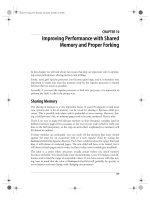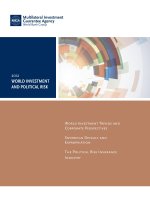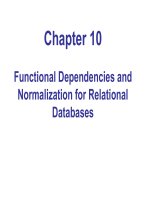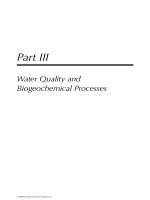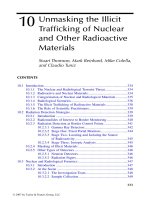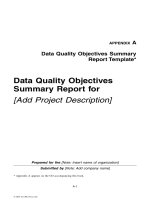Chapter 10 Managing Political Risk, Government Relations, and Alliances
Bạn đang xem bản rút gọn của tài liệu. Xem và tải ngay bản đầy đủ của tài liệu tại đây (289.46 KB, 28 trang )
Chapter ten
Managing Political Risk,
Government Relations, and
Alliances
Chapter Objectives
The four specific objectives of this chapter are:
1.
2.
3.
4.
EXAMINE how MNCs evaluate political risk.
PRESENT some common methods used for
managing and reducing political risk.
DISCUSS strategies to mitigate political risk and
develop productive relations with governments.
DESCRIBE challenges to and strategies for
effectively managing alliances.
The Nature and Analysis of
Political Risk
Political risk
Macro political risk analysis
Analysis that reviews major political decisions likely to
affect all enterprises in the country
Micro political risk analysis
The likelihood that a business foreign investment will be
constrained by a host government’s policy.
Analysis directed toward government politics and actions
that influence selected sectors of the economy or specific
foreign businesses in the country
/>x.htm
Macro Risk Factors
Freezing the movement of assets out of the host
country
Placing limits on the remittance of profits or capital
Devaluing the currency
Refusing to abide by the contractual terms of
agreements previously signed with MNC
Industrial piracy (counterfeiters)
Political turmoil
Government corruption
2006 Transparency International
Corruption Perceptions Index
Corruption Perceptions Index
Micro Risk Factors
Some MNCs are treated differently than others
Industry regulation
Taxes on specific types of business activity
Restrictive local laws
Impact of WTO and EU regulations on American
MNCs
Government policies that promote exports and
discourage imports
Evaluation of Political Risk
Terrorism and Its
Overseas Expansion
Terrorism: the use of force or violence against
others to promote political or social views
Three types of terrorism: amateur, religiously
motivated, and classic
MNCs disinclined to set up operations in countries
with high terrorism risk
MNCs must assess political risk, install modern
security, compile crisis plans, and prepare
employees for possible situations
Expropriation Risk
Expropriation: the seizure of businesses by a
host country with little, if any, compensation
to owners
Indigenization laws
Require nations to hold a majority interest in an
operation
Operational Profitability
in Risk Analysis
Most MNCs are more concerned with operational
profitability than expropriation
They are concerned with ability to make desired
return on investment
Require MNCs to use domestic suppliers vs. those from
other company-owned facilities or purchase in world market
Restrict the amount of profit taken out of country
Wages and salary that must be paid to employees
/>
Managing Political Risk and
Government Relations
Managing Political Risk and
Government Relations
1.
2.
3.
Transfer risks
Operational risks
Ownership control risks
Political Risks: Transfer Risks
Government policies that limit transfer of
capital, payments, production, people, and
technology in and out of country
Tariffs on exports and imports
Restrictions on exports
Dividend remittance
Capital repatriation
Political Risks: Operational
Risks
Government policies and procedures that
directly constrain management and
performance of local operations
Price controls
Financing restrictions
Export commitments
Taxes
Local sourcing requirements
Political Risks:
Ownership Control Risks
Government policies or actions that inhibit
ownership or control of local operations
Foreign-ownership limitations
Pressure for local participation
Confiscation
Expropriation
Abrogation of proprietary rights
General Nature of Investment
Conglomerate investment
Vertical investment
Type of high-risk investment in which goods or services
produced are not similar to those produced at home
Production of raw materials or intermediate goods that are
to be processed into final products
Horizontal investment
MNC investment in foreign operations to produce the same
goods or services as those produced at home
Special Nature of Investment
Three sectors of economic activity
Primary sector: agriculture, forestry, mineral
exploration and extraction
Industrial sector: manufacturing
Service sector: transportation, finance, insurance,
and related industries
Special Nature of Investment
Special nature of foreign direct investment can be categorized
as one of five types (see Slide 12):
Type I: highest-risk venture (type V is lowest)
Risk factor is assigned based on sector, technology, and
ownership
Primary sector industries usually have highest risk factor,
service sector industries have next highest; industrial sector
industries have lowest
Firms with technology not available to government should firm
be taken over have lower risk than those with technology that
is easily acquired
Wholly owned subsidiaries have higher risk than partially
owned subsidiaries
Quantifying Variables in
Managing Political Risk
Each factor is given minimum or maximum
score; scores tallied for overall evaluation of
risk
Slide 21 gives an example of a quantitative
list of political risk criteria
Factors typically quantified
Political and economic environment
Domestic economic conditions
External economic conditions
Quantifying Political Risk
Techniques for Responding to
Political Risk
Three related corporate political strategies
Relative bargaining power analysis (1)
The MNC works to maintain a bargaining power position
stronger than that of host country
Integrative, protective, and defensive techniques (2)
(Integrative techniques help overseas operation become part
of host country’s infrastructure)
Developing good relations with host government and other
local political groups
Producing as much of product locally as possible with use of
in-country suppliers and subcontractors
Creating joint ventures and hiring local people to manage and
run operation (cont’d)
Techniques for Responding to
Political Risk (cont’d)
Doing as much local R&D as possible
Developing effective labor-management relations
(Protective and defensive techniques discourage the host
government from interfering in operations)
Doing as little local manufacturing as possible and conducting
all research and development outside country
Limiting responsibility of local personnel and hiring only those
who are vital to operation
Raising capital from local banks and host government as well
as outside sources
Diversifying production of product among number of countries
Techniques for Responding to
Political Risk (cont’d)
Proactive political strategies (3)
Lobbying, campaign financing, advocacy and
other political interventions designed to shape and
influence political decisions prior to impact on firm
Formal lobbying
Campaign financing
Seeking advocacy through embassy and consulates of
home country
Formal public relations and public affairs activities such
as grassroots campaigning and advertising
Use of Integrative, Protective,
and
Defensive Techniques


